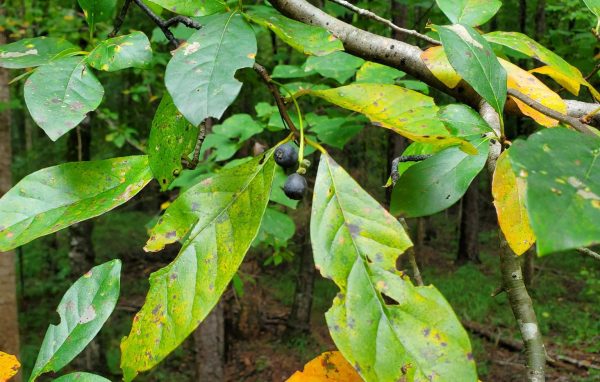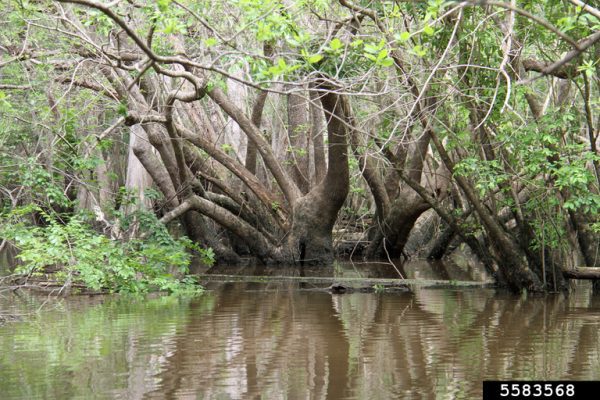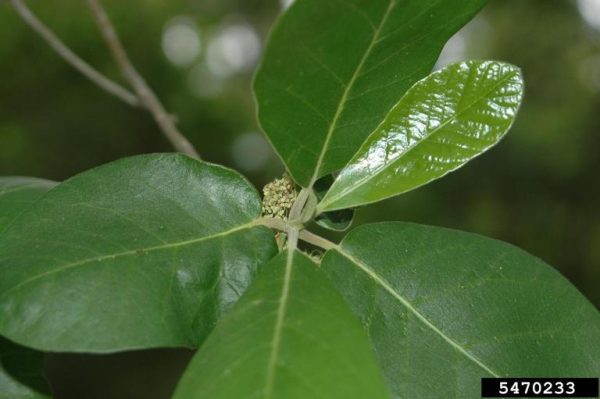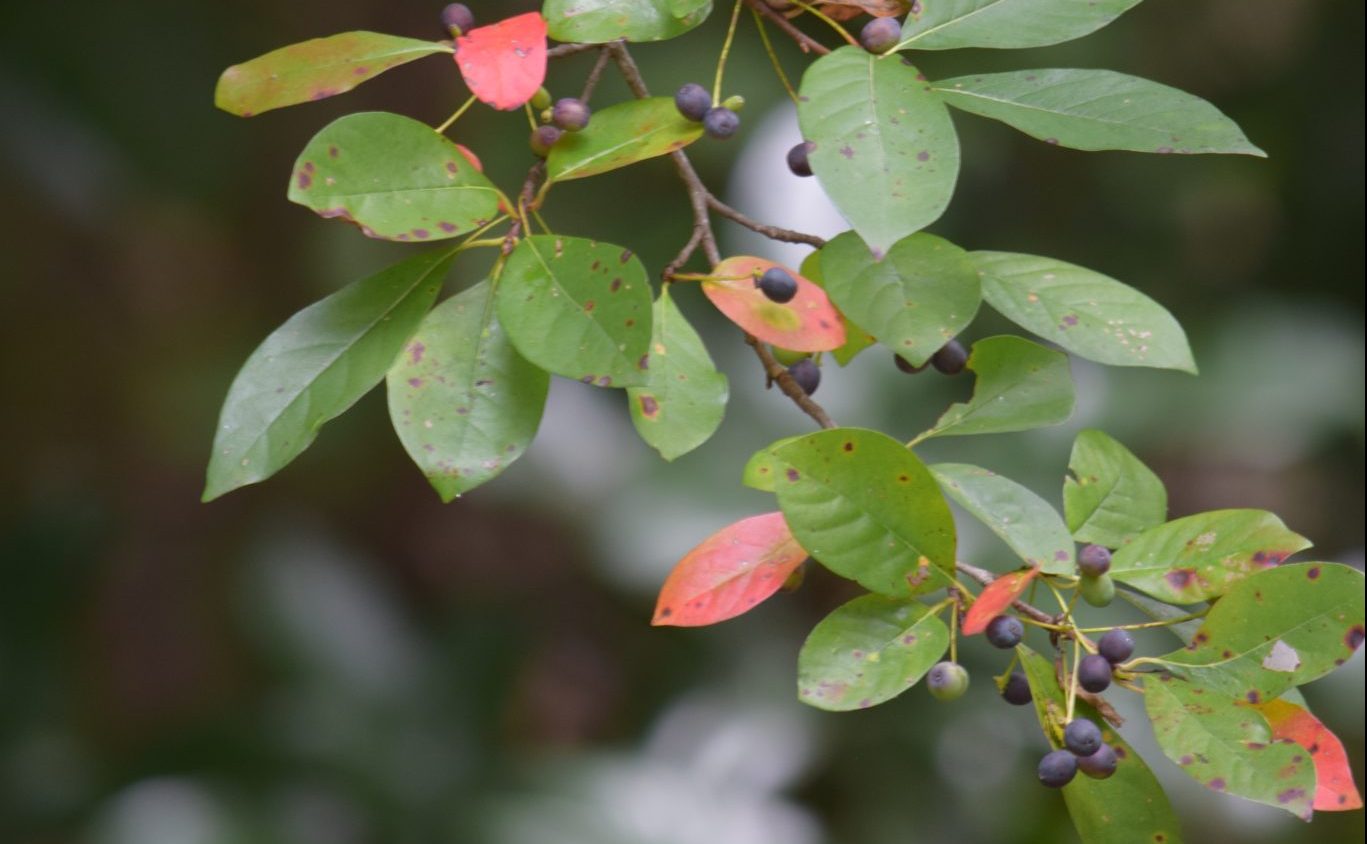Forestry

There are two species of tupelo in Alabama with notable fruiting potential. Black tupelo (Nyssa sylvatica) is a common, large, and widespread tree with small fruits that are excellent for wildlife. Ogeechee tupelo (Nyssa ogeche) is a less common, smaller tree with larger fruit and greater yields.
Black Tupelo
General Description

Black tupelo tree
Black tupelo, also known as black gum, is generally between 60-80 feet in height, occasionally reaching over 100 feet. It grows wild across most of the state, thriving in a wide variety of site and soil conditions, from wet bottomlands to sandhills. Its leaves are typically about 3 inches long, simple and glabrous (smooth), sometimes with a few scattered large and uneven marginal teeth. The bark ranges from deeply furrowed to somewhat scaly in appearance It tends towards a straight and single trunked growth form, with branches often at right angles to the trunk. The fruit, which grows singly or in clusters of two or three is dark blue-purple when it ripens in the fall. In the fall, foliage typically brilliant scarlet or occasionally deep purple.
Uses for People
Black tupelo fruit is richly flavored and can be used to or make jellies or flavored drinks, ice cream or other dishes. However, the fruit is small with a large seed and relatively little flesh. Harvest is difficult, as the trees are tall and birds almost always get to the fruit before they fall. The honey produced from black tupelo flowers is of excellent quality and flavor. Black tupelo also makes it a good ornamental tree in larger yards or parks due to its large size and beautiful fall color. Its wood is very tough and can be used for a variety of tools, railroad ties, and other purposes.
Uses for Wildlife

Black tupelo foliage
Black tupelo fruit is very popular with a wide variety of birds, and fallen fruit is eaten by many mammals and insects. The flowers are used by pollinating insects, and deer will eat the young foliage. As a large tree it provides both shade and habitat structure. One of the longest-lived hardwoods in the eastern US, it may provide these benefits for a very long time.
Cultivation
Black tupelo is readily available online and from nurseries. Its ability to grow and thrive in many areas and soil types makes it an easy tree to cultivate. It readily grows from seed and may be sown from wild fruit as well. Be sure to plant multiple trees to ensure fruit production as black tupelo are dioecious, needing both male and female trees for successful pollination. In general, trees will reach optimal growth in mesic to wet sites along bottomlands and lower slopes, rarely becoming a large tree if planted in dry areas. Trees can still grow and produce fruit on drier sites, however. The trees will grow best if started in a somewhat sheltered location and may fail to thrive if planted in the open, in heavy shade or in crowded areas. Light compost and mulch around the base of young trees will suppress competition and potentially increase fruit production. In areas of high deer pressure, it might be necessary to protect young trees until foliage is out of reach. Due to its naturally large size, black tupelo may be best utilized as a wildlife and honey tree rather than pruned heavily as a fruit producer.
Ogeechee Tupelo
General Description

Ogeechee tupelo tree
James R. Holland, Bugwood.org
Ogeechee tupelo is also known as white tupelo, Ogeechee-lime, wild-lime, river-lime, and sour gum. It is only rarely found in Alabama, with its natural range generally restricted to the far southeastern corner of the state. A relatively small tree that often grows as a many-trunked large shrub, it rarely grows taller than 50 feet. The trunk may have a swollen base when trees are grown in wet sites. The leaves are 4-6 inches long and glabrous (smooth) on the upper surface with pubescent (fuzzy) undersides. Fall color is yellow. The bark is grey-brown, fairly smooth, and very thin. As a result, this species is extremely sensitive to fire. The flowers are green-yellow and inconspicuous, but the fruits are almost two inches long and vibrant red when ripe. The species is partially dioecious, with some trees being solely male and others having both perfect and female flowers.
Uses for People
Ogechee tupelo consistently produces large yields of both flowers and fruit. The flowers make the highest grade of tupelo honey trees are planted extensively in parts of Georgia and Florida for this purpose. The fruit are the largest of any tupelo and have a thick flesh and acidic flavor. They contain one or two large seeds. The fruit can be eaten fresh, with the juice used as a substitute for lime juice in various recipes. They can also be made into drinks and preserves, or dried and chewed as a snack. With dense foliage and an attractive growth form, Ogeechee tupelo can make a nice shade tree although the fruit can be messy.
Uses for Wildlife

Ogeechee tupelo foliage
Karan A. Rawlins, University of Georgia, Bugwood.org
Many species of animal eat the Ogeechee tupelo fruit , including birds, mammals, insects, and some reptiles. The flowers are excellent for many pollinators. Trees provides good habitat structure and shade in riparian areas. When growing in its preferred habitat near creeks and ponds, its shade can help keep the water cooler during the summer.
Cultivation
Ogeechee tupelo can be grown widely across the southern half of the state. It is site specific, growing best in wet and acidic soils that are sandy or loamy in texture. If not planted in a wet area, trees should be watered regularly during hot or dry periods. Readily available online and from some native plant nurseries, it is advised to plant multiple trees to ensure good pollination and yield. Its large fruit yields can be messy and attract rodents, so it is best planted away from high-activity areas and paths. While it can grow well in partial shade, full sun is best for good yields. However, if planted on drier sites, partial shade may reduce stress during hot and dry conditions. This species grows readily from seed and also suckers freely.
As it can grow to a height that makes harvesting difficult, pruning for a lower, multi stemmed growth form is advisable. If honey production rather than fruit is the priority, plan to plant a large stand of trees.
Disclaimer: If harvesting fruit from wild trees, ensure that the species is correctly identified. Wash well and use only intact, fully ripe fruit.

